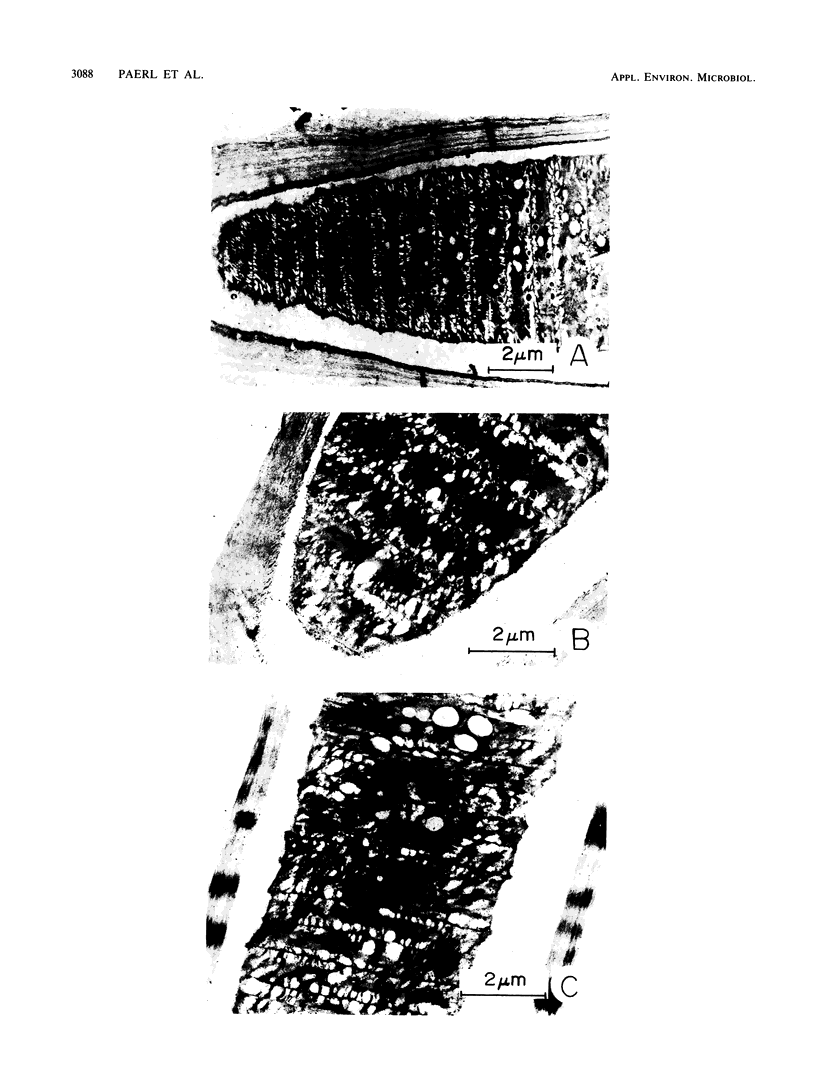Abstract
The nonheterocystous filamentous cyanobacterial genus Lyngbya is a widespread and frequently dominant component of marine microbial mats. It is suspected of contributing to relatively high rates of N2 fixation associated with mats. The ability to contemporaneously conduct O2-sensitive N2 fixation and oxygenic photosynthesis was investigated in Lyngbya aestuarii isolates from a North Carolina intertidal mat. Short-term (<4-h) additions of the photosystem II (O2 evolution) inhibitor 3(3,4-dichlorophenyl)-1,1-dimethylurea stimulated light-mediated N2 fixation (nitrogenase activity), indicating potential inhibition of N2 fixation by O2 production. However, some degree of light-mediated N2 fixation in the absence of 3(3,4-dichlorophenyl)-1,1-dimethylurea was observed. Electron microscopic immunocytochemical localization of nitrogenase, coupled to microautoradiographic studies of 14CO2 fixation and cellular deposition of the tetrazolium salt 2,4,5-triphenyltetrazolium chloride, revealed that (i) nitrogenase was widely distributed throughout individual filaments during illuminated and dark periods, (ii) 14CO2 fixation was most active in intercalary regions, and (iii) daylight 2,4,5-triphenyltetrazolium chloride reduction (formazan deposition) was most intense in terminal regions. Results suggest lateral partitioning of photosynthesis and N2 fixation during illumination, with N2 fixation being confined to terminal regions. During darkness, a larger share of the filament appears capable of N2 fixation.
Full text
PDF






Images in this article
Selected References
These references are in PubMed. This may not be the complete list of references from this article.
- Bebout B. M., Paerl H. W., Crocker K. M., Prufert L. E. Diel interactions of oxygenic photosynthesis and n(2) fixation (acetylene reduction) in a marine microbial mat community. Appl Environ Microbiol. 1987 Oct;53(10):2353–2362. doi: 10.1128/aem.53.10.2353-2362.1987. [DOI] [PMC free article] [PubMed] [Google Scholar]
- Donze M., Haveman J., Schiereck P. Absence of photosystem 2 in heterocysts of the blue-green alga Anabaena. Biochim Biophys Acta. 1972 Jan 21;256(1):157–161. doi: 10.1016/0005-2728(72)90170-3. [DOI] [PubMed] [Google Scholar]
- Fay P., Kulasooriya S. A. Tetrazolium reduction and nitrogenase activity in heterocystous blue-green algae. Arch Mikrobiol. 1972;87(4):341–352. doi: 10.1007/BF00409133. [DOI] [PubMed] [Google Scholar]
- Ludden P. W., Preston G. G., Dowling T. E. Comparison of active and inactive forms of iron protein from Rhodospirillum rubrum. Biochem J. 1982 Jun 1;203(3):663–668. doi: 10.1042/bj2030663. [DOI] [PMC free article] [PubMed] [Google Scholar]
- Paerl H. W., Bland P. T. Localized Tetrazolium Reduction in Relation to N(2) Fixation, CO(2) Fixation, and H(2) Uptake in Aquatic Filamentous Cyanobacteria. Appl Environ Microbiol. 1982 Jan;43(1):218–226. doi: 10.1128/aem.43.1.218-226.1982. [DOI] [PMC free article] [PubMed] [Google Scholar]
- Paerl H. W., Priscu J. C., Brawner D. L. Immunochemical localization of nitrogenase in marine trichodesmium aggregates: relationship to n(2) fixation potential. Appl Environ Microbiol. 1989 Nov;55(11):2965–2975. doi: 10.1128/aem.55.11.2965-2975.1989. [DOI] [PMC free article] [PubMed] [Google Scholar]
- Stewart W. D., Fitzgerald G. P., Burris R. H. In situ studies on N2 fixation using the acetylene reduction technique. Proc Natl Acad Sci U S A. 1967 Nov;58(5):2071–2078. doi: 10.1073/pnas.58.5.2071. [DOI] [PMC free article] [PubMed] [Google Scholar]
- Wolk C. P. Movement of carbon from vegetative cells to heterocysts in Anabaena cylindrica. J Bacteriol. 1968 Dec;96(6):2138–2143. doi: 10.1128/jb.96.6.2138-2143.1968. [DOI] [PMC free article] [PubMed] [Google Scholar]




